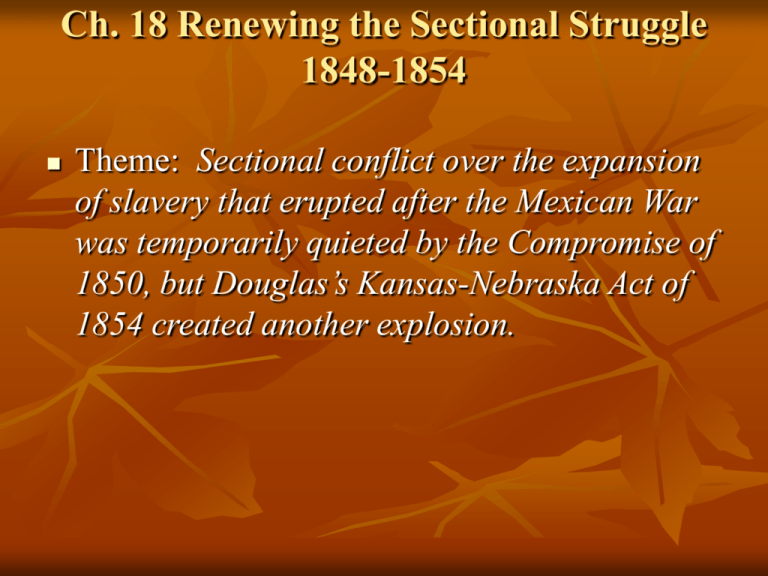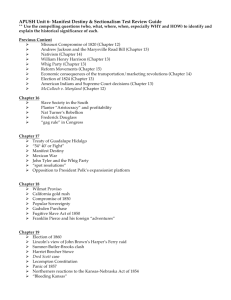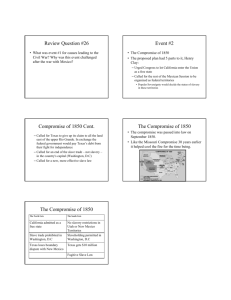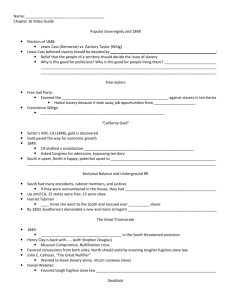Kansas-Nebraska Act 1854
advertisement

Ch. 18 Renewing the Sectional Struggle 1848-1854 Theme: Sectional conflict over the expansion of slavery that erupted after the Mexican War was temporarily quieted by the Compromise of 1850, but Douglas’s Kansas-Nebraska Act of 1854 created another explosion. Results of the Mexican War? 1. The 17-month war cost $100,000,000 and 13,000+ American lives (mostly of disease). 2. New territories were brought into the Union which forced the explosive issue of SLAVERY to the center of national politics. * Brought in 1 million sq. mi. of land (incl. TX) 3. These new territories would upset the balance of power between North and South. 4. Created two popular Whig generals who ran for President. 5. Manifest Destiny was partially realized. Election of 1848 Democratic candidate: General Lewis Cass “popular sovereignty” Avoided slavery issue Whig Candidate: Zachary Taylor “Hero of Buena Vista Never held office or voted for pres. Avoided slavery issue Free Soil Party Candidate: Martin Van Buren: “Free Soil, Free Speech, Free Labor, Free Men!” “Barnburners” – discontented northern Democrats. Anti-slave members of the Liberty and Whig Parties. Opposition to the extension of slavery in the new territories! WHY? The 1848 Presidential Election Results √ GOLD! At Sutter’s Mill, 1848 John A. Sutter California Gold Rush, 1849 49er’s “Gold Rush” Thousands rushed to CA to strike it rich! Majority did not Mostly criminals and “virtueless women” High rates of crime, violence and murder 1849: CA drafted Constitution which prohibited slavery and they applied for admission to Union Outraged Southern Politicians-tipped balance CA-free state, NM & Utah wanted admission as free state-set precedent for Mexican territories The South 1850 Major concerns Texans threaten to seize territory east of Rio Grande and north to the 42nd parallel District of Columbia wanting to abolish slavery Loss of runaway slaves/underground RR Wanted more effective Fugitive Slave Law Threat of Secession Prominent figures-Clay, Calhoun & Webster address Congress Clay: wanted North & South to make concessions and favored a more feasible Fugitive Slave Law Calhoun: rejected Clay’s proposals because they didn’t protect southern rights Webster: New Fugitive Slave Law & felt Wilmot Proviso answered slave question Missouri Compromise 1850 Concessions to North Concessions to South California admitted as free state •Territory disputed by Texas and New Mexico to be surrendered to New Mexico •Abolition of the slave trade (not slavery) in the District of Columbia. • • New Mexico and Utah formed as territories-issue of slavery open to “popular sovereignty” •Texas paid $10 million from federal government as compensation •More stringent Fugitive •Slave law Who got the better deal from this compromise? The North!!! CA as free state tipped Senate balance of power permanently New Mexico and Utah use popular sovereignty to determine slavery issue Environment of territories supported free soil South needed to gain territory Fugitive Slave Law 1850 “Bloodhound Bill” Fleeing slave can’t testify on own behalf & were denied trial by jury Feared this would set a precedent for whites Federal Commissioner in charge of case received $5 if slave freed, $10 if not Northerners who aided slaves to escape faced heavy fines, jail etc. Created more abolitionists Personal Liberty laws passed Results of the Compromise of 1850 and Fugitive Slave Law Debate gave North time to accumulate material and moral strength for war Bolstered Yankee resistance to secession South angry because North failed to enforce Fugitive Slave Law End of Whig Party Election of 1852 Democrats: Franklin Pierce: endorsed Compromise of 1850 and Fugitive Slave Law Whigs: Winfield Scott-Praised Compromise of 1850 Whig party split Pierce wins Pacific Railroad/Gadsden Purchase Legacy of Mexican War=problems with transportation to new territories-Ca. and Oregon Solution: build transcontinental railroad Where?? Through south or north? Why?? Gadsden Purchase 1853 $10 million dollars Territorial Growth to 1853 Kansas-Nebraska Act 1854 Stephen Douglas introduced legislation to counter Gadsden Purchase Territory of Nebraska would be split in twoNebraska & Kansas Slavery issue settled by popular sovereignty Kansas most likely slave, Nebraska free Problem: contradicted Missouri Compromise of 1820 (forbid slavery in the proposed Nebraska territory north of the 36’ 30 line) Fallout from Kansas-Nebraska Act Southerners supported Act Northerners resisted Led to violence “Bleeding Kansas” Destroyed Missouri Compromise of 1820 and 1850 Increased tension over Fugitive Slave Law Paved way to Civil War Question??? Was Stephen Douglas an instigator of war because he introduced the Kansas-Nebraska Act? Or was war inevitable even if the bill had not been enacted?








